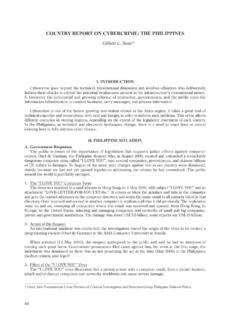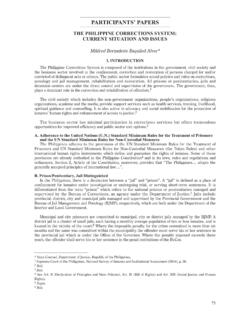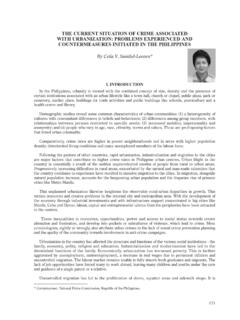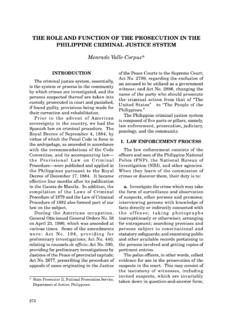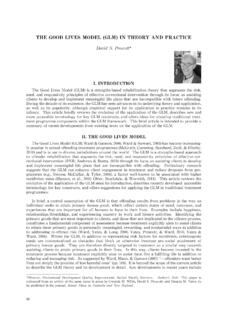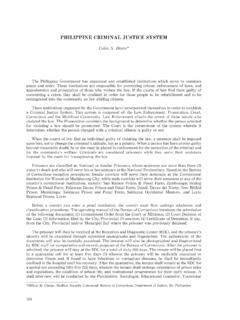Transcription of VICTIMOLOGY – PAST, PRESENT AND FUTURE
1 116 VICTIMOLOGY past , PRESENT AND FUTUREJohn P. J. Dussich*I. HISTORICAL OVERVIEW OF VICTIMOLOGYA. The Early Roots The word victim has its roots in many ancient languages that covered a great distance from north-western Europe to the southern tip of Asia and yet had a similar linguistic pattern: victimain Latin; v h,w oh, w gin Old European; w h, w hiin Old High German; v in Old Norse; weihs in Gothic; and, vinak tiinSanskrit (Webster s 1971). VICTIMOLOGY as an academic term contains two elements: One is the Latin word Victima which translates into victim . The other is the Greek word logos which means a system of knowledge, the direction ofsomething abstract, the direction of teaching, science, and a writings about the victim appeared in many early works by such criminologists as Beccaria(1764), Lombroso (1876), Ferri (1892), Gar falo (1885), Sutherland (1924), Hentig (1948), Nagel (1949),Ellenberger (1955), Wolfgang (1958) and Schafer (1968), the concept of a science to study victims and theword VICTIMOLOGY had its origin with the early writings of Beniamin Mendelsohn (1937; 1940), theseleading to his seminal work where he actually proposed the term VICTIMOLOGY in his article A New Branchof Bio-Psycho-Social Science, VICTIMOLOGY (1956).
2 It was in this article that he suggested the establishmentof an international society of VICTIMOLOGY which has come to fruition with the creation of the World Society ofVictimology, the establishment of a number of victimological institutes (including the creation here in Japanof the Tokiwa international VICTIMOLOGY institute ); and, the establishment of international journals which arenow also a part of this institute . Mendelsohn provided us with his VICTIMOLOGY vision and blueprint; and, ashis disciples we have followed his guidance. We now refer to Mendelsohn as The Father of VICTIMOLOGY .B. Critical Dates in VICTIMOLOGY 1924 Edwin Sutherland includes a chapter on victims in his criminology textbook. 1937 Beniamin Mendelsohn publishes his writings on the rapist and his victim. 1941 Hans von Hentig publishes article on victim and criminal interactions.
3 1947 Beniamin Mendelsohn coins the term VICTIMOLOGY in a French journal. 1948 Hans von Hentig publishes his book The Criminal and His Victim. 1949 Frederic Wertham first used the word VICTIMOLOGY in a book Show of Violence. 1957 Margery Fry proposes victim compensation in the London Times. 1958 Marvin Wolfgang studies homicide victims; uses the term victim precipitation . 1963 New Zealand enacts the first Criminal Compensation Act. 1965 California is the first state in the USA to start Victim Compensation. 1966 Japan enacts Criminal Indemnity Law. 1966 USA starts to survey crime victims not reported to the police 1967 Canada creates a Criminal Compensation Injuries Act as does Cuba and Switzerland. 1968 Stephan Schafer writes the first VICTIMOLOGY textbook The Victim and His Criminal. 1972 The first three victim assistance programmes are created in St.
4 Louis, Missouri, San Francisco,California and in Washington, D. C. 1973 the first international symposium on VICTIMOLOGY is held in Jerusalem, Israel. 1974 the first police-based victim advocate project is started in Fort Lauderdale, Florida, USA. 1975 The first Victim Rights Week is organized by the Philadelphia District Attorney,* Associate Professor, Criminology Department, California State University, Fresno; Director, Tokiwa InternationalVictimology institute , Tokiwa University VICTIMOLOGY Graduate School, , USA. 1976 John Dussich launches the National Organization of Victim Assistance (NOVA) in Fresno,California, USA. 1976 Emilio Viano launches the first scholarly journal devoted to VICTIMOLOGY . 1976 James Rowland creates the first Victim Impact Statement in Fresno, California, USA. 1979 The World Society of VICTIMOLOGY is founded in Munster, Germany.
5 1980 Mothers Against Drunk Drivers (MADD) is founded by Candi Lightner after one of her twindaughters was killed by a drunk driver who was a repeat offender. 1981 President Ronald Reagan proclaims the first national Victims Rights Week in April. 1982 the first Victim Impact Panel established by MADD to educate drunk drivers about how theirvictims suffered, started in Rutland, Massachusetts, USA. 1984 The Victims of Crime Act (VOCA) establishes the national Crime Victims Fund from federalcrime fines to pay for state victim compensation and services. 1985 The United Nations unanimously adopts the Declaration of Basic Principles of Justice forVictims of Crime and Abuse of Power. 1987 The US Department of Justice opens the National Victims Resource Centre in Rockville,Maryland. 1988 The first Indian Nations: Justice for Victims of Crime conference is held by the Office forVictims of Crime in Rapid City, South Dakota, USA.
6 1990 The European Forum for Victim Services was founded by all the national organizations inEurope working for victims of crime in consultative status with the Council of Europe and the UN. 1999 The United Nations and the US Office for Victims of Crime publish the Guide for Policymakerson the Implementation of the United Nations Declaration of Basic Principles of Justice for Victims ofCrime and Abuse of Power and the Handbook on Justice for Victims: On the Use and Application ofthe United Nations Declaration of Basic Principles of Justice for Victims of Crime and Abuse ofPower. 2002 On 11 April, 66 the Rome Statute was ratified & went into force on 1 July at which time theInternational Criminal Courtbecame effective and it included the creation of a Victim and WitnessUnit. 2003 On October 2ndthe Tokiwa international VICTIMOLOGY institute , in Mito Japan opened its doorsto promote victim rights, to conduct seminars, courses, publish an international journal, and hostannual symposia and lectures and research about VICTIMOLOGY .
7 2004 The World Society of VICTIMOLOGY at its annual Executive Committee meeting in Orlando,Florida adopts a dramatic new strategic plan to commit itself to the ideals and promises of the UNDeclaration (see Appendix A). 2005 Japan puts the UN Basic Principles of Justice for Victims of Crime and Abuse of Power intotheir national legislation by adopting a new fundamental law for crime victims. To ensure that theprinciples would be initiated, the Prime Minister established a cabinet level committee. The new lawincludes services for victims, restitution from the offender, information about criminal justice and aright to formally participate in the criminal justice process. Victim AssistanceSince the mid 1970s victim assistance programmes in America had to cope with the realization that thisnew field did not have a professional corps of people with special training in dealing with crime who were working in the programmes were a mixture of medical doctors, ministers, psychiatrists,psychologists, social workers, nurses, on-the-job trained counsellors, persons outside the helpingprofessions and volunteers with all levels of training.
8 There were no international or national professionalstandards. There was no certificate or degree to prepare someone to do the work of helping victims , before formal victim assistance programmes evolved, there were some people trained to workwith victim problems, especially people who had been helping child abuse and family violence victims. Thesewere social workers. Today, the victim services scene has changed. There are a wide array of professionalsand non-professionals working with victims. These would include: social workers, psychologists,psychiatrists, nurses, medical doctors, non-specific professionals (who received their formal degrees inother fields but were trained to help victims in the numerous training schools which are both part andindependent of academic settings); and, volunteers (who also received their training in the numeroustraining schools which are both part and independent of academic settings, many of which are 40 hourtraining modules offered by the victim service agencies where they work).
9 Today the field of victimassistance is the major career field in VICTIMOLOGY for persons wanting to help victims of crime directly. The131ST international SENIOR SEMINARVISITING EXPERTS PAPERS 117 RESOURCE MATERIAL SERIES largest and oldest university offering a bachelor s degree in VICTIMOLOGY and a victim servicescertificate is the California State University, Fresno. Worldwide, it can be estimated that there are about20,000 victim service programmes now operating: reducing suffering and facilitating KEY CONCEPTS IN VICTIMOLOGYA. Concepts1. Victim has it roots in the early religious notions of suffering, sacrifice and death. This concept of victim was well known in the ancient civilizations, especially in Babylonia, Palestine, Greece, andRome. In each of these civilizations the law mandated that the victim should be recognized as aperson who deserved to be made whole again by the Crime victim is a person who has been physically, financially or emotionally injured and/or hadtheir property taken or damaged by someone committing a Victimogenesis refers to the origin or cause of a victimization; the constellation of variables whichcaused a victimization to Victim Precipitation a victimization where the victim causes, in part or totally, their Vulnerability is a physical, psychological, social, material or financial condition whereby a person oran object has a weakness which could render them a victim if another person or persons wouldrecognize these weaknesses and take advantage of them.
10 6. General Victim is a person who has been physically, financially or emotionally injured and/or hadtheir property taken or damaged by someone, an event, an organization or a natural phenomenon. 7. Victimization refers to an event where persons, communities and institutions are damaged orinjured in a significant way. Those persons who are impacted by persons or events suffer a violationof rights or significant disruption of their well VICTIMOLOGY is an academic scientific discipline which studies data that describes phenomena andcausal relationships related to victimizations. This includes events leading to the victimization, thevictim s experience, its aftermath and the actions taken by society in response to thesevictimizations. Therefore, VICTIMOLOGY includes the study of the precursors, vulnerabilities, events,impacts, recoveries, and responses by people, organizations and cultures related to Abuse of Power is the violation of a national or international standard in the use of organizedpowerful forces such that persons are injured physically, mentally, emotionally, economically, or intheir rights, as a direct and intentional result of the misapplication of these Victim Assistance, Support or Services are those activities which are applied in response tovictimizations with the intention of relieving suffering and facilitating recovery.
